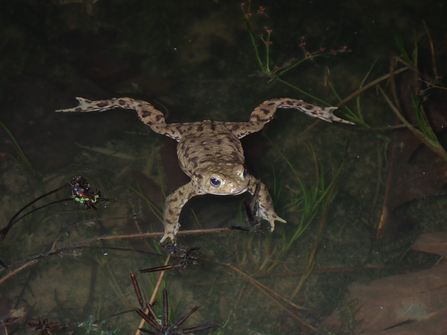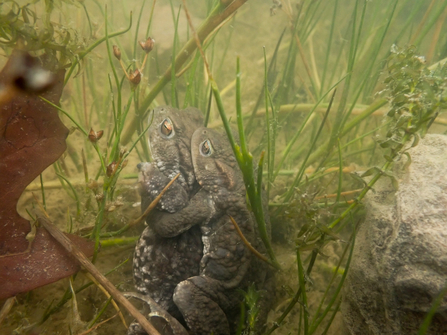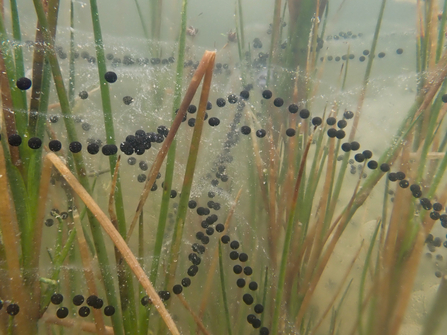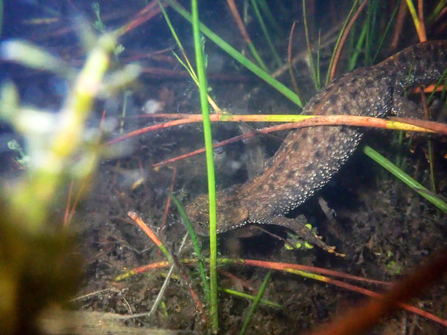One of the best things that we can do to encourage wildlife in our gardens is to create a pond. Whether its just an old bowl buried in in a corner of the garden or something on a grander scale, it will almost certainly bring some new creatures into your garden.
Fantastic creatures and how to help them
Common Toad for header © Tim Ward
Our pond in mid-March © Tim Ward
Create a pond and the creatures will come
To illustrate this point, last summer when the lockdown eased, we visited some relatives in Norfolk who had just been redesigning their small courtyard garden. They had a small plastic pond about 70cm across that was overgrown, and since the goldfish disappeared, didn’t think much was living in it anymore. While emptying it out they found a larva which they thought was a dragon fly and they asked me if I could confirm what it was. I immediately realised that it was not a dragonfly nymph but a Great Diving Beetle larva. When fully grown this is just about the largest aquatic insect that you can find in the UK and a spectacular predator, with two enormous jaws and a voracious appetite for tadpoles. After a year or so in a pond it pupates in the margins and emerges as large water beetle. You can imagine my surprise when looking again in the bottom of the pond I saw something else moving which turned out to be an adult female beetle. I can’t imagine how these creatures managed to find this tiny little patch of water in the middle of a town, not just once but twice over a period of a couple of years. Also, this pond must have been a home to numerous tadpoles and other aquatic creatures to enable the larva to have grown to almost maturity. I am always amazed by what you can find when you start to poke around in a pond, whatever the size!

Common Toad Floating on pond © Tim Ward

Mating common toads © Tim Ward
Our pond is a great place to find fantastic creatures
One of the things we did when we moved into our house was to create a pond. We are lucky to have enough space to create quite a big one. We deliberately made it with gently sloping sides and covered the liner with a thick layer of soil from the hole that we dug (after putting a protective mat over and under the liner to stop it being punctured) to make it as close to a natural pond as possible. It’s now in its third year and already looks as if it has always been there. During the winter the cold weather causes the water plants to die down and the water clears. When it’s not frozen over I can look into it and see that although it’s not full of life, some creatures are still active. I can usually find a couple of water-boatmen rowing away just under the surface and one or two snails gliding around over the muddy bottom. However, at this time of year, when the sun starts to warm the water, the amphibians arrive.

Unlike frog spawn, toad spawn is laid in long strands and wound around water plants to keep it in place © Tim Ward
Amazing amphibians
In our pond, the first to arrive are Great Crested Newts, closely followed by frogs, then we get a mass invasion of toads, and finally, the two smaller newt species join in: Smooth and Palmate Newts. We are very fortunate in living in this part of the UK as it is one of the few places where all five of the commoner native amphibian species can be found in the same pond. The only native species we don’t get here are the rare Natterjack Toad which is only found in specific dune and heathland habitats and the very rare and reintroduced Pool Frog.
In my experience frogs are opportunistic in selecting breeding pools and if the conditions are right, will happily spawn in small and transient bodies of water, so often are quick to appear in a small garden pond. Toads seem to be fussier and prefer larger and more permanent water bodies and are well known for their habit of gathering in large numbers at traditional breeding sites. However, in the larger ponds that I have made they have always turned up in the first year so they are clearly able to adapt rapidly to colonise new suitable habitats. Toads are also much less dependent on water outside of the breeding season and as soon as the spawn is laid the leave the pond to forage in the undergrowth for the rest of the year.
Video of toads frolicking (https://youtu.be/cyOePulsI-k)
A short night-time video of toads frolicking in our pond

Female Great Created Newt. The ‘warty’ lumps on their skin is characteristic of this species and is why they are sometimes known as Warty Newts © Tim Ward
Great Crested Newts are generally in decline in Europe due to habitat loss. The relatively large population in the UK is significant in ensuring the survival of this species; hence its special protected status under the Wildlife and Countryside Act which means that it is an offence to deliberately disturb them or damage their habitats. In Montgomeryshire this species is relatively common and quite likely to be encountered in gardens sheltering under stones and bits of wood during prolonged dry spells, or on damp nights, walking around the garden, even if you don’t have a pond.
Smooth Newts are widespread across the UK but less common in more acidic habitats in the west where the Palmate Newt is more abundant. These two species are very similar in size and overall colouration but can be separated if you can see their throat. The Smooth Newt has spots on its throat and the Palmate Newt has a plain pale pink throat. In the breeding season the male Palmate Newt has webbed hind feet to further aid identification and is the reason for the species name. Both species are happy to breed in shallow pools and if you have a pond it is well worth checking to see if you have one or the other or both in residence.
Supporting a healthy amphibian population
Despite their relative abundance, all amphibian populations in the UK are under threat due to loss of habitat resulting from changes in land use, draining of wetlands and intensification of agriculture. However, creating a pond, large or small, in a wildlife friendly garden, is a great way to help maintain a healthy population of them in the UK. However, if you want to encourage amphibians it is best not to have any fish in the pond.
If you have a pond in your garden, now is a great time to take a torch out in the evening and have a look and see what you can find. If you haven’t perhaps now is the time to start planning to create one
Happy wildlife watching
Tim
Disclaimer
Any views or opinions represented in this blog are personal and belong solely to the author and do not represent those of people, institutions or organizations that the author may or may not be associated with in professional or personal capacity, unless explicitly stated

